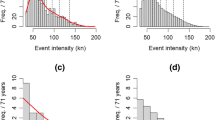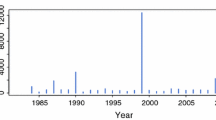Abstract
Severe wind storms are one of the major natural hazards in the extratropics and inflict substantial economic damages and even casualties. Insured storm-related losses depend on (i) the frequency, nature and dynamics of storms, (ii) the vulnerability of the values at risk, (iii) the geographical distribution of these values, and (iv) the particular conditions of the risk transfer. It is thus of great importance to assess the impact of climate change on future storm losses. To this end, the current study employs—to our knowledge for the first time—a coupled approach, using output from high-resolution regional climate model scenarios for the European sector to drive an operational insurance loss model. An ensemble of coupled climate-damage scenarios is used to provide an estimate of the inherent uncertainties. Output of two state-of-the-art global climate models (HadAM3, ECHAM5) is used for present (1961–1990) and future climates (2071–2100, SRES A2 scenario). These serve as boundary data for two nested regional climate models with a sophisticated gust parametrizations (CLM, CHRM). For validation and calibration purposes, an additional simulation is undertaken with the CHRM driven by the ERA40 reanalysis. The operational insurance model (Swiss Re) uses a European-wide damage function, an average vulnerability curve for all risk types, and contains the actual value distribution of a complete European market portfolio. The coupling between climate and damage models is based on daily maxima of 10 m gust winds, and the strategy adopted consists of three main steps: (i) development and application of a pragmatic selection criterion to retrieve significant storm events, (ii) generation of a probabilistic event set using a Monte-Carlo approach in the hazard module of the insurance model, and (iii) calibration of the simulated annual expected losses with a historic loss data base. The climate models considered agree regarding an increase in the intensity of extreme storms in a band across central Europe (stretching from southern UK and northern France to Denmark, northern Germany into eastern Europe). This effect increases with event strength, and rare storms show the largest climate change sensitivity, but are also beset with the largest uncertainties. Wind gusts decrease over northern Scandinavia and Southern Europe. Highest intra-ensemble variability is simulated for Ireland, the UK, the Mediterranean, and parts of Eastern Europe. The resulting changes on European-wide losses over the 110-year period are positive for all layers and all model runs considered and amount to 44% (annual expected loss), 23% (10 years loss), 50% (30 years loss), and 104% (100 years loss). There is a disproportionate increase in losses for rare high-impact events. The changes result from increases in both severity and frequency of wind gusts. Considerable geographical variability of the expected losses exists, with Denmark and Germany experiencing the largest loss increases (116% and 114%, respectively). All countries considered except for Ireland (−22%) experience some loss increases. Some ramifications of these results for the socio-economic sector are discussed, and future avenues for research are highlighted. The technique introduced in this study and its application to realistic market portfolios offer exciting prospects for future research on the impact of climate change that is relevant for policy makers, scientists and economists.
Similar content being viewed by others
References
Beersma JJ, Rider KM, Komen GJ, Kaas E, Kharin VV (1993) An analysis of extra-tropical storms in the North Atlantic region as simulated in a control and 2xCO2 time-slice experiment with a high-resolution atmospheric model. Tellus A49(3):347–361
Berz GA (1993) Global warming and the insurance industry. Interdiscip Sci Rev 18(2):120–125
Boer GJ (1995) Some dynamical consequences of greenhouse gas warming. Atmos Ocean 33(4):731–751
Carnell RE, Senior CA (1998) Changes in mid-latitude variability due to increasing greenhouse gases and sulfate aerosols. Clim Dyn 14:369–383
Changnon SA, Changnon D, Fosse ER, Hoganson DC, Roth RJ, Totsch JM (1997) Effects of recent weather extremes on the insurance industry: major implications for the atmospheric sciences. Bull Am Meteorol Soc 78(3):425–435
Christensen JH, Christensen OB (2007) A summary of the PRUDENCE model projects of changes in European climate by the end of this century. Clim Change 81(Suppl 1):7–30. doi:10.1007/s10584-006-9210-7
Christensen JH, Carter TR, Giorgi F (2002) Prudence employs new methods to assess European climate change. E O S 83:147
Davies HC (1976) Lateral boundary formulation for multilevel prediction models. Q J R Meteorol Soc 102(432):405–418
DelGenio AD, Lacis AA, Ruedy RA (1991) Simulations of the effect of a warmer climate on atmospheric humidity. Nature 351(6325):382–385
Della-Marta P, Liniger MA, Appenzeller C, Bresch DN, Köllner-Heck P, Muccione V (2009) Improved estimates of the European winter wind storm climate and the risk of reinsurance loss using climate model data. JAMC (in press)
Déqué M, Rowell DP, Lüthi D, Giorgi F, Christensen JH, Rockel B, Jacob D, Kjellstroem E, de Castro M, van den Hurk BJJM (2007) An intercomparison of regional climate simulations for Europe: assessing uncertainties in model projections. Clim Change 81(Suppl 1):53–70. doi:10.1007/s10584-006-9228-x
Frei C, Schär C (2001) Detection probability of trends in rare events: theory and application to heavy precipitation in the Alpine region. J Climate 14:1568–1584
Geng QZ, Sugi M (2003) Possible change of extratropical cyclone activity due to enhanced greenhouse gases and sulfate aerosols—Study with a high-resolution AGCM. J Climate 16:2262–2274
Heck P, Bresch DN, Tröber S (2006) The effects of climate change: storm damage in europe on the rise. Swiss Re Focus Report. http://www.swissre.com/
Held IM (1993) Large-scale dynamics and global warming. Bull Amer Meteor Soc 74(2):228–241
Hoskins BJ, McIntyre ME, Robertson AW (1985) On the use and significance of isentropic potential vorticity maps. Q J R Meteorol Soc 111:877–946
IPCC (2001) Climate change. The scientific bases. Cambridge University Press, Cambridge, 881 pp
IPCC (2007) Climate change. The physical science basis. http://www.ipcc.ch
Johns TC, Gregory JM, Ingram WJ, Johnson CE, Jones A, Lowe JA, Mitchell JFB, Roberts DL, Sexton DM, Stevenson DS, Tett SFB, Woodage MJ (2003) Anthropogenic climate change for 1860 to 2100 simulated with the HadCM3 model under updated emissions scenarios. Clim Dynamics 20:583–612
Kessler E (1969) On the distribution and continuity of water substance in atmospheric circulations. Meteorol Monogr AMS 32:84
Klawa M, Ulbrich U (2003) A model for the estimation of storm losses and the identification of severe winter storms in Germany. Nat Hazards Earth Syst Sci 3:725–732
Knippertz P, Ulbrich U, Speth P (2000) Changing cyclones and surface wind speeds over the North Atlantic and Europe in a transient GHG experiment. Clim Res 15(2):109–122
Lamb HH, Fydendahl K (1991) Grading of storms. In: Historic storms of the North Sea, British Isles and Northwest Europe. Cambridge University Press, Cambridge, 204 pp, 7–32
Lambert SJ (1995) The effects of enhanced greenhouse warming on winter cyclone frequencies and strengths. J Climate 8:1447–1452
Leckebusch GC, Ulbrich U (2004) On the relationship between cyclones and extreme windstorm events over Europe under climate change. Glob Planet Change 44(1–4):181–193
Leckebusch GC, Koffi B, Ulbrich U, Pinto JG, Spangehl T, Zacharias S (2006) Analysis of frequency and intensity of European winter storm events from a multi-model perspective, at synoptic and regional scales. Clim Res 31:59–74
Leckebusch GC, Ulbrich U, Fröhlich L, Pinto J (2007) Property loss potentials for European mid-latitude storms in a changing climate. Geophys Res Lett 34:L05703. doi:10.1029/2006GL027663
Lin Y-L, Farley RD, Orville HD (1983) Bulk parametrization of the snow field in a cloud model. J Appl Meteor 22(6):1065–1092
Lüthi D, Cress A, Frei C, Schär C (1996) Interannual variability and regional climate simulations. Theor Appl Climatol 53:85–209
Majewski D (1991) Numerical methods in atmospheric models. ECMWF SEM NUM METH A 2:147–191
Pielke RA Jr, Landsea CW, Musulin RT, Downton M (1999) Evaluation of catastrophe models using a normalized historical record. Why it is needed and how to do it. J Insur Regul 18(2):177–194
Pinto J, Fröhlich EL, Leckebusch GC, Ulbrich U (2007) Changing European storm loss potentials under modified climate conditions according to ensemble simulations of the ECHAM5/MPI-OM1 GCM. Nat Hazards Earth Syst Sci 7:165–175
Pope DV, Gallani M, Rowntree R, Stratton A (2000) The impact of new physical parameterizations in the Hadley Centre climate model HadAM3. Clim Dyn 16:123–146
Raible CC, Saaroni H, Ziv B, Wild M (2009) Winter synoptic-scale variability over the Mediterranean Basin under future climate conditions as simulated by the ECHAM5. Clim Dyn (available online). doi:10.1007/s00382-009-0678-5
Rockel B, Woth K (2007) Future changes in near surface wind speed extremes over Europe from an ensemble of RCM simulations. Clim Change 81(Suppl 1):267–280. doi:10.1007/s10584-006-9227-y
Roeckner E, Bäuml G, Bonaventura L, Brokopf R, Esch M, Giorgetta M, Hagemann S, Kirchner I, Kornblueh L, Manzini E, Rhodin A, Schlese U, Schulzweida U, Tompkins A (2003) The atmospheric general circulation model ECHAM5. Part I: model description. Max Planck Institute for Meteorology Rep. 349, 127pp. www.mpimet.mpg.de
Roeckner E, Brokopf R, Esch M, Giorgetta M, Hagemann S, Kornblueh L, Manzini E, Schlese U, Schulzweida U (2006) Sensitivity of simulated climate to horizontal and vertical resolution in the ECHAM5 atmosphere model. J Climate 19(16):3771–3791
Schär C, Vidale PL, Lüthi D, Frei C, Häberli C, Liniger M, Appenzeller C (2004) The role of increasing temperature variability in European summer heat waves. Nature 427:332–336
Schrodin R (ed) (1995) Dokumentation des EM/DM Systems. Deutscher Wetterdienst, Offenbach a. Main
Schubert M, Perlwitz J, Blender R, Fraedrich K, Lunkeit F (1998) North Atlantic cyclones in CO2- induced warm climate simulations: frequency, intensity, and tracks. Clim Dyn 14:827–837
Schwierz C, Appenzeller C, Davies H, Liniger M, Müller W, Stocker T, Yoshimori M (2006) Challenges posed by and approaches to the study of seasonal-to-decadal climate variability. Clim Change 79(1–2):31–63
Steppeler J, Doms G, Schättler U, Bitzer HW, Gassmann A, Damrath U, Gregoric G (2003) Meso-gamma scale forecasts using the nonhydrostatic model LM. Meteorol Atmos Phys 82:75–96
Tiedtke M (1989) A comprehensive mass flux scheme for cumulus parametrization in large-scale models. Mon Weather Rev 117(8):1779–1800
Ulbrich U, Christoph M (1999) A shift of the NAO and increasing storm track activity over Europe due to anthropogenic greenhouse gas forcing. Clim Dyn 15:551–559
Uppala SM, Källberg PW, Simmons AJ, Andrae U, da Costa Bechtold V, Fiorino M, Gibson JK, Haseler J, Hernandez A, Kelly GA, Li X, Onogi K, Saarinen S, Sokka N, Allan RP, Andersson E, Arpe K, Balmaseda MA, Beljaars ACM, van de Berg L, Bidlot J, Bormann N, Caires S, Chevallier F, Dethof A, Dragosavac M, Fisher M, Fuentes M, Hagemann S, Hlm E, Hoskins BJ, Isaksen L, Janssen PAEM, Jenne R, McNally AP, Mahfouf J-F, Morcrette J-J, Rayner NA, Saunders RW, Simon P, Sterl A, Trenberth KE, Untch A, Vasiljevic D, Viterbo P, Woollen J (2005) The ERA-40 re-analysis. Q J R Meteorol Soc 131:2961–3012. doi:10.1256/qj.04.176
Van Ulden AO, van Oldenborgh GJ (2006) Large-scale atmospheric circulation biases and changes in global climate simulations and their importance for climate change in Central Europe. Atmos Chem Phys 6:863–881
Vidale PL, Lüthi D, Frei C, Seneviratne S, Schär C (2003) Predictability and uncertainty in a regional climate model. J Geophys Res 108(D18):Art. No. 4586
Vidale PL, Lüthi D, Wegmann R, Schär C (2007) European summer climate variability in a heterogeneous multi-model ensemble. Clim Change 81(Suppl 1):209–232. doi:10.1007/s10584-006-9218-z
Watson CC, Johnson ME (2004) Hurricane loss estimation models: opportunities for improving the State of the Art. Bull Amer Meteor Soc 85(11):1713
Wernli H, Dirren S, Liniger MA, Zillig M (2002) Dynamical aspects of the life cycle of the winter storm ’Lothar’ (24–26 December 1999). Q J R Meteor Soc 128(580):405–429
Woth K, Weisse R, von Storch H (2006) Climate change and North Sea storm surge extremes: an ensemble study of storm surge extremes expected in a changed climate projected by four different regional climate models. Ocean Dyn 56(1):3–15
Zecchetto S, Cappa C (2001) The spatial structure of the Mediterranean Sea winds revealed by ERS-scatterometer. Int J Remote Sens 22(1):45–70. doi:10.1080/014311601750038848
Zimmerli R et al (2003) Natural catastrophes and reinsurance. Swiss Reinsurance company publication. http://www.swissre.com/
Author information
Authors and Affiliations
Corresponding author
Rights and permissions
About this article
Cite this article
Schwierz, C., Köllner-Heck, P., Zenklusen Mutter, E. et al. Modelling European winter wind storm losses in current and future climate. Climatic Change 101, 485–514 (2010). https://doi.org/10.1007/s10584-009-9712-1
Received:
Accepted:
Published:
Issue Date:
DOI: https://doi.org/10.1007/s10584-009-9712-1




